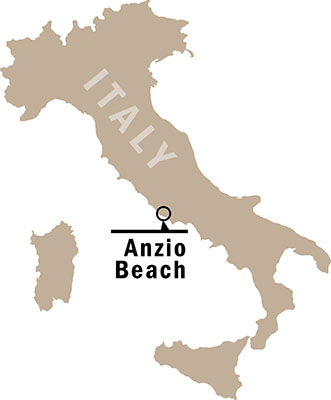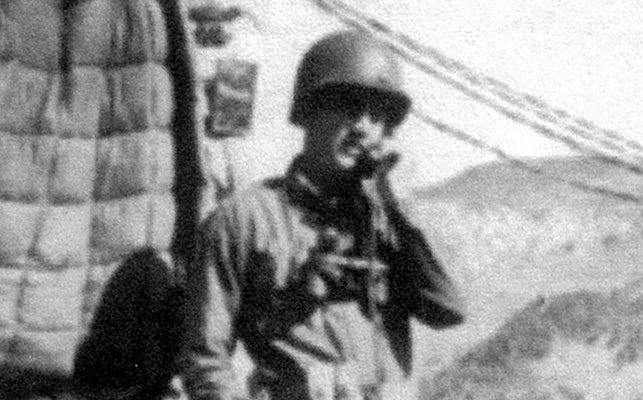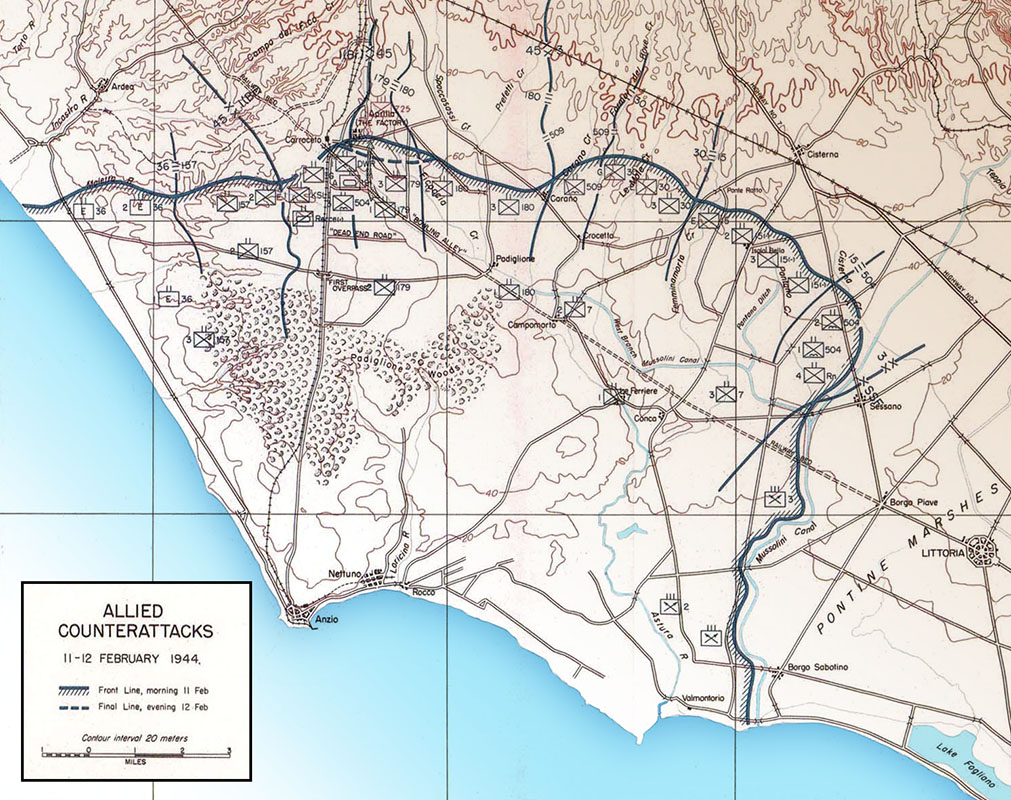SIDEBAR
DOWNLOAD

The First Special Service Force (FSSF) landed at Anzio on 1 February 1944 and moved into defensive positions within twenty-four hours. Their mission was to protect the right flank of the beachhead, about thirteen kilometers of the fifty-two-kilometer salient that had become the Anzio beachhead. To the front of the FSSF position was the Mussolini Canal, a drainage project started in 1926 to drain the marshes and turn the swampy Littoria Plain into farmland.1 At its widest point, the canal was about sixty yards across and deep enough to form an effective antitank barrier. In order to keep the Germans from launching a significant attack, Brigadier General Robert T. Frederick, the FSSF commander, ordered an aggressive patrolling regimen with squads and platoons harassing the enemy every night. Sometimes these patrols simply disrupted enemy activities by cutting communications lines, while others conducted raids and sometimes prisoner snatches. For the most part, these patrols were extremely successful and caused the Germans to believe a much larger force opposed them; however, one such patrol went awry for a Forceman and led to a classic escape and evasion.

On the dark evening of 14 March 1944, the commander of 3rd Company, 3rd Regiment, FSSF, First Lieutenant (1LT) T. Mark Radcliffe, led a five-man ambush patrol across the Mussolini Canal. In the course of the patrol, Radcliffe stopped to investigate a suspicious noise and was pounced upon by four or five German soldiers, who quickly bound and gagged him. Unaware of his capture, Radcliffe’s patrol continued with its mission, only discovering their leader’s absence much later. In the morning, the Germans took their prisoner to the town of Littoria for interrogation, but failed to blindfold him, allowing 1LT Radcliffe to take mental note of various German positions and troop locations, something that he hoped would help him at some future point.

1LT Radcliffe was introduced to his interrogator in the semi-basement of a damaged house with windows about four feet from the ground, maps on the wall, and full of German troops. Clad in the uniform of the elite Herman Göring Panzer Division, the interrogator was one Captain Urlich, who claimed to have been a stockbroker in Philadelphia before the war, which accounted for his proficiency in English. Per his training, 1LT Radcliffe offered only his name, rank, and service number in answer to all of Captain Urlich’s questions. The interrogation continued unabated for about twenty minutes, at which point, apparently frustrated from his lack of success, Captain Urlich suddenly struck Radcliffe across the right side of his throat with a solid rubber truncheon. The blow paralyzed Radcliffe’s vocal cords, and he lost the ability to speak in anything above a whisper for four weeks.
As if by providence, the interrogation came to an abrupt halt when an Allied artillery barrage hit the area. The Germans hurried to protective shelters, leaving a lone guard on watch. The guard was rightfully nervous and continually checked the effects of the barrage, peeking through the door and window, paying little attention to his prisoner. 1LT Radcliffe saw his chance: grabbing a piece of wood, he hit the guard on the side of the neck, knocking him out. The next few minutes were a whirlwind of frantic activity. After first grabbing a map, Radcliffe freed two other prisoners and then ran through the waning moments of the artillery barrage in search of concealment. 1LT Radcliffe knew they had only minutes before the Germans discovered their escape and began to look for them. At last, they found concealment in a large evergreen tree. Climbing up into the branches, Radcliffe and his companions stayed there all day as the Germans searched the ground nearby in vain, never looking up.
Under cover of darkness, the escapees finally descended from their hidden perch and made further plans. The two soldiers Radcliffe had freed, one British and the other French, decided to attempt to reenter Allied lines in another area, one they were more familiar with, so they parted ways with their American liberator. Radcliffe was determined to head to his former sector, where he knew the terrain, and more importantly, how to navigate through the extensive minefields. Traveling through the night and dodging German patrols, he gradually moved closer to Allied lines. Closer to safety, but not close enough, Radcliffe was spotted by a German mortar crew, which opened fire and wounded him. Losing blood and in pain from shrapnel wounds in his left foot and near his eyes, Radcliffe was barely able to find a hiding place for the next day.

By now, 1LT Radcliffe had been missing for three days, but his comrades in the Force had not given up on him. Several patrols from 3rd Company had been continuously searching for their company commander. Finally, the patrol led by Sergeant “Big Swede” Erickson, an original member of Radcliffe’s patrol, chanced upon the wounded officer. He was alive, though weak with blood loss. A noted character within the Force, Sergeant Erickson lived up to his reputation once again. Instead of greeting his wounded commander in relief, Erickson grabbed Radcliffe by the ears and excitedly started to pound his head into the ground, yelling “You little son of a bitch! Where ya been?”2 No one knows how long the enthusiastic greeting would have continued, because a group of Germans soon spotted the patrol and opened fire. The rescuers grabbed Radcliffe and returned across the Mussolini Canal to the safety of their own lines.
At the 3rd Regiment command post, 1LT Radcliffe was given a preliminary debriefing by the Regimental Intelligence Officer, 1LT Bill Story. This was a somewhat difficult undertaking for Radcliffe, since he was still in rough shape. He was weak from his three-day evasion and blood loss, and he still could not speak above a low whisper because of the blow to his throat. Radcliffe and Story overcame the challenge by passing notes for the few minutes they had before Lieutenant Colonel Walker, the 3rd Regiment commanding officer, arrived at the command post to welcome Radcliffe back and to take him to the field hospital. In spite of his poor condition, Radcliffe was able to convey to 1LT Story the intelligence that he had gathered during his journey to the interrogation in Littoria.3 This information was used to target the areas with artillery, resulting in the destruction of several ammunition dumps and enemy positions.4
In need of medical care, Radcliffe journeyed to the aid station and then to the field hospital in the Anzio beachhead. It was determined that the shrapnel wound to his foot had to be operated on at the 36th Combat Hospital near Naples, so he was transported there for further care. After the operation, Radcliffe had recuperated for twenty-two days when he heard that soldiers at the hospital were being sent to the replacement depot for reassignment. For many soldiers, especially those assigned to special units like the FSSF and the Rangers, being reassigned was not only considered a demotion, but they also lost the camaraderie and friendship forged through training and the early campaigns in Southern Italy. Rather then run the risk of being assigned out of the FSSF, Radcliffe left the hospital without orders. Intent on rejoining his unit, he began his second escape and evasion in less than a month—this time from American forces.
While the “escape” from the hospital was relatively simple, getting from Naples to Anzio posed a bigger problem, since Radcliffe had no official access to transportation. As befit a resourceful first lieutenant, Radcliffe solved the problem of the return to Anzio with unconventional thinking and ingenuity. By chance, he ran into a friend from Salt Lake City who was flying an L-19 spotter plane in and out of Anzio as a courier service. Radcliffe was able to convince the friend to take him along on his next flight to Anzio, but the friend feared being court-martialed for taking an unauthorized passenger. So they worked out a compromise: Once the L-19 landed and was taxing toward the parking area, Radcliffe would roll out of the plane undetected and make his way back to FSSF headquarters. The plan was executed successfully and with efficiency. In less than thirty days, 1LT Radcliffe had successfully conducted two escapes and evasions (through both enemy and “enemy” territory), and had reunited with his unit. He had little time to rest from his exploits, however. He was soon summoned to BG Frederick’s headquarters for a special mission: he was to lead the first U.S. patrol into Rome.
